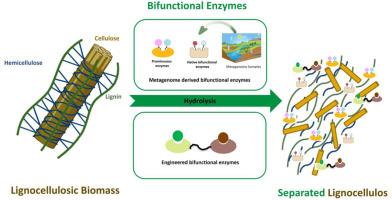Discovery and engineering of bifunctional enzymes for lignocellulose degradation: Metagenomic and computational approaches
Q1 Immunology and Microbiology
引用次数: 0
Abstract
Efficient degradation of lignocellulosic biomass is vital for converting plant-based waste into renewable fuels and chemicals. Owing to its complex composition of cellulose, hemicellulose, and lignin, its enzymatic breakdown often requires multiple enzymes to act synergistically. Bifunctional enzymes that combine two catalytic activities in a single protein offer a promising solution. This review highlights recent advances in the identification and engineering of bifunctional enzymes for lignocellulose degradation, particularly through metagenomics, protein fusion and computational design. Functional pairings, such as cellulase/xylanase, were examined with a focus on their synergistic effects, substrate specificity, and stability. Promiscuous and naturally evolved bifunctional enzymes from extreme or uncultured environments are also discussed. Advances in silico modeling and directed evolution have enhanced enzyme properties such as thermostability and substrate range. The review concludes with an outlook on the challenges and opportunities of implementing bifunctional enzymes to improve the economic and technical viability of biomass conversion.

木质纤维素降解双功能酶的发现和工程:宏基因组和计算方法
木质纤维素生物质的有效降解对于将植物废料转化为可再生燃料和化学品至关重要。由于其纤维素、半纤维素和木质素的复杂组成,它的酶分解通常需要多种酶协同作用。将两种催化活性结合在一个蛋白质中的双功能酶提供了一个有希望的解决方案。本文综述了近年来在木质纤维素降解双功能酶的鉴定和工程方面的进展,特别是在宏基因组学、蛋白质融合和计算设计方面的进展。功能配对,如纤维素酶/木聚糖酶,研究重点是它们的协同作用,底物特异性和稳定性。还讨论了从极端或非培养环境中混杂和自然进化的双功能酶。硅建模和定向进化的进步提高了酶的性能,如热稳定性和底物范围。本文最后展望了利用双功能酶提高生物质转化的经济和技术可行性所面临的挑战和机遇。
本文章由计算机程序翻译,如有差异,请以英文原文为准。
求助全文
约1分钟内获得全文
求助全文
来源期刊

Biotechnology Reports
Immunology and Microbiology-Applied Microbiology and Biotechnology
CiteScore
15.80
自引率
0.00%
发文量
79
审稿时长
55 days
期刊介绍:
Biotechnology Reports covers all aspects of Biotechnology particularly those reports that are useful and informative and that will be of value to other researchers in related fields. Biotechnology Reports loves ground breaking science, but will also accept good science that can be of use to the biotechnology community. The journal maintains a high quality peer review where submissions are considered on the basis of scientific validity and technical quality. Acceptable paper types are research articles (short or full communications), methods, mini-reviews, and commentaries in the following areas: Healthcare and pharmaceutical biotechnology Agricultural and food biotechnology Environmental biotechnology Molecular biology, cell and tissue engineering and synthetic biology Industrial biotechnology, biofuels and bioenergy Nanobiotechnology Bioinformatics & systems biology New processes and products in biotechnology, bioprocess engineering.
 求助内容:
求助内容: 应助结果提醒方式:
应助结果提醒方式:


